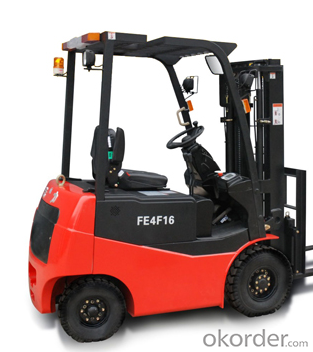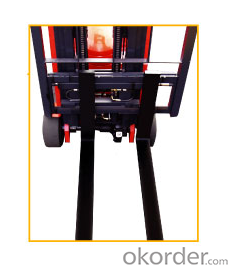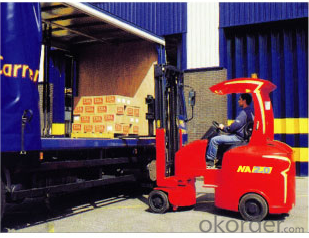Loading Port:Shanghai
Payment Terms:TT OR LC
Min Order Qty:1 unit
Supply Capability:1 unit/month
Forklift Description:
Automatic transmission with high efficiency and productivity;
Combined axles with minimum turning radius and aisle width;
Low energy consumption, high stability, maximum visibility;
Minimum noise and pollution
Wide-version mast with ergonomic design for high working efficiency.
The Battery-powered is our newly invented battery powered forkLift. It has a high visibility range , has an automatic transmission, it easy to operate and easy to charge. Both AC powered and DC powered models are available. It is an ideal machine for conveying product
Forklift Specification:
| Designation | Lift height | Free lif | Closed mast | Extended mast height | Tilt forward/ backward | without sideshift | |
| h3mm | h2mm | h1mm | h4mm | α/β(°) | FE4F16AC | FE4F18AC | |
| two-stage | 2500 | 150 | 1745 | 3423 | 6/12 | 1600 | 1750 |
| 2700 | 150 | 1845 | 3623 | 6/12 | 1600 | 1750 | |
| 3000 | 150 | 1995 | 3923 | 6/12 | 1600 | 1750 | |
| 3300 | 150 | 2145 | 4223 | 6/12 | 1600 | 1750 | |
| 3600 | 150 | 2345 | 4523 | 6/6 | 1400 | 1450 | |
| 4000 | 150 | 2545 | 4923 | 6/6 | 1300 | 1330 | |
| 4300 | 150 | 2695 | 5223 | 6/6 | 1200 | 1200 | |
| 4500 | 150 | 2795 | 5423 | 6/6 | 1100 | 1100 | |
| two-stage full free | 2500 | 1200 | 1735 | 3423 | 6/12 | 1600 | 1750 |
| 2700 | 1300 | 1835 | 3623 | 6/12 | 1600 | 1750 | |
| 3000 | 1500 | 1995 | 3923 | 6/12 | 1600 | 1750 | |
| 3300 | 1700 | 2135 | 4223 | 6/12 | 1600 | 1750 | |
| 3600 | 1800 | 2335 | 4523 | 6/6 | 1400 | 1450 | |
| 4000 | 2054 | 2585 | 4923 | 6/6 | 1300 | 1330 | |
| three-stage | 4000 | 1300 | 1930 | 4923 | 6/6 | 1250 | 1280 |
| 4300 | 1400 | 2030 | 5223 | 6/6 | 1200 | 1220 | |
| 4500 | 1500 | 2080 | 5423 | 6/6 | 1150 | 1150 | |
| 4800 | 1690 | 2180 | 5723 | 3/6 | 1050 | 1050 | |
| 5000 | 1800 | 2215 | 5923 | 3/6 | 750 | 800 | |
| 5500 | 1850 | 2445 | 6423 | 3/6 | 500 | 550 | |
| 6000 | 2000 | 2615 | 6923 | 3/6 | 350 | 400 | |
| Identifica tion | 1.1 | Manufacture(abbreviation) | unit | Noblelift | Noblelift |
| 1.2 | Manufacturer’s type designation | FE4F16AC | FE4F18AC | ||
| 1.3 | Drive:electric(battery or mains),diesel, petrol gas,manual | electric | electric | ||
| 1.4 | Type of operation:hand,seated,pedestrian, standing, order-picker | seated | seated | ||
| 1.5 | Load Capacity /rated load | Q (kg) | 1600 | 1750 | |
| 1.6 | Load center distance | C(mm) | 500 | 500 | |
| 1.8 | Load distance, centre of drive axle to fork | X(mm) | 410 | 410 | |
| 1.9 | Wheelbase | y(mm) | 1250 | 1250 | |
| Weights | 2.1 | Service Weight incl.battery(see line 6.5) | Kg | 3006 | 3086 |
| 2.2 | Axle loading, laden front/rear | Kg | 4004/502 | 4364/522 | |
| 2.3 | Axle loading, unladen front/rear | Kg | 1200/1806 | 1224/1862 | |
| Wheels, Chassis | 3.1 | Tyres:solid rubber,superelastic,pneumatic, polyurethane | Pneumatic | Pneumatic | |
| 3.2 | Tyres size, front | 6.50-10-10PR | 6.50-10-10PR | ||
| 3.3 | Tyres size, rear | 5.00-8-8PR | 5.00-8-8PR | ||
| 3.5 | Wheels, number front/rear(x=driven wheels) | 2x/2 | 2x/2 | ||
| 3.6 | Track width,front | b10(mm) | 890 | 890 | |
| 3.7 | Track width,rear | b11(mm) | 920 | 920 | |
| Basic Dimensions | 4.1 | Mast/fork carriage tilt forward/backward | α/β(¡ã) | 6/12 | 6/12 |
| 4.2 | Lowered mast height | h1(mm) | 1995 | 1995 | |
| 4.3 | Free lift | h2(mm) | 150 | 150 | |
| 4.4 | Lift height | h3(mm) | 3000 | 3000 | |
| 4.5 | Extended mast height | h4(mm) | 3923 | 3923 | |
| 4.7 | Overhead load guard height | h6(mm) | 2110 | 2110 | |
| 4.8 | Seat height/standing height | h7(mm) | 1060 | 1060 | |
| 4.12 | Coupling height | h10(mm) | 350 | 350 | |
| 4.19 | Overall length | l1(mm) | 3160 | 3160 | |
| 4.2 | Length to face of forks | l2(mm) | 2010 | 2010 | |
| 4.21 | Overall width | b1/b2(mm) | 1070 | 1070 | |
| 4.22 | Fork dimensions | s/e/l(mm) | 35x100x950 | 35x100x950 | |
| 4.24 | Fork carriage width | b3(mm) | 920 | 920 | |
| 4.31 | Ground clearance,laden, under mast | m1(mm) | 60 | 60 | |
| 4.32 | Ground clearance, center of wheelbase | m2(mm) | 130 | 130 | |
| 4.33 | Aisle width for pallets 1000x1200 crossways | Ast(mm) | 3525 | 3525 | |
| 4.34 | Aisle width for pallets 800x1200 lengthways | Ast(mm) | 3725 | 3725 | |
| 4.35 | Turning radius | Wa(mm) | 1900 | 1900 | |
| 4.36 | Smallest pivot point distance | b13(mm) | 566 | 566 | |
| Performan ce | 5.1 | Travel Speed, laden/unladen | km/h | 13/15 | 13/15 |
| 5.2 | Lift speed, laden/unladen | m/s | 0.27/0.37 | 0.25/0.37 | |
| 5.3 | Lowering speed, laden/unladen | m/s | 0.35/0.42 | 0.33/0.42 | |
| 5.5 | Drawbar pull, laden/unladen S2 60min | N | 1900/1830 | 1930/1870 | |
| 5.6 | Max.drawbar pull,laden/unladen S2 5min | N | 5750/5560 | 5760/5580 | |
| 5.7 | Gradient performance, laden/unladen S2 30min | % | 6/9 | 5.5/8.5 | |
| 5.8 | Max.gradient performance, laden/unladen S2 5min | % | 10/18 | 9.5/17 | |
| 5.1 | Service brake | hydr. | hydr. | ||
| E-Motor | 6.1 | Drive motor rating s2 60min | kw | 8 | 8 |
| 6.2 | Lift motor rating at s3 15% | kw | 7.5 | 7.5 | |
| 6.3 | Battery acc. To DIN43531/35/36A,B,C,no | BS | BS | ||
| 6.4 | Battery voltage, norminal capacity K5 | V/Ah | 48/400 | 48/400 | |
| 6.5 | Battery weight | kg | 650 | 650 | |
| Battery dimensions l/w/h | mm | 970/600/438 | 970/600/438 | ||
| Other Details | 8.1 | Type of drive control | Mosfet Impulse/AC | ||
| 8.2 | Operating pressure for attachments | bar | 14.5 | 14.5 | |
| 8.3 | Oil volume for attachments | l/min | 30 | 30 | |
| 8.4 | Sound level at driver’s ear according to EN12053 | dB(A) | 70 | 70 | |
Forklift Images:



FAQ of forklift:
Q: What’s the function of forklift?
A: A forklift truck (also called a lift truck, a fork truck, or a forklift) is a powered industrial truck used to lift and move materials short distances. The forklift was developed in the early 20th century by various companies including the transmission manufacturing company Clark and the hoist company Yale & Towne Manufacturing. Following World War II the use and development of the forklift truck has greatly expanded worldwide. Forklifts have become an indispensable piece of equipment in manufacturing and warehousing operations.
Q: What’s the general operations of forklift:
A: Forklift cab with control layout.
Forklifts are rated for loads at a specified maximum weight and a specified forward center of gravity. This information is located on a nameplate provided by the manufacturer, and loads must not exceed these specifications. In many jurisdictions it is illegal to remove or tamper with the nameplate without the permission of the forklift manufacturer.
Q: What are the Forklift safety Standards?
A: 1, Forklift safety is subject to a variety of standards world wide. The most important standard is the ANSI B56—of which stewardship has now been passed from the American National Standards Institute (ANSI) to the Industrial Truck Standards Development Foundation after multi-year negotiations. ITSDF is a non-profit organization whose only purpose is the promulgation and modernization of the B56 standard.
2, Other forklift safety standards have been implemented in the United States by the Occupational Safety and Health Administration (OSHA) and in the United Kingdom by the Health and Safety Executive.
3, Driver safety: In many countries forklift truck operators must be trained and certified to operate forklift trucks. Certification may be required for each individual class of lift that an operator would use.